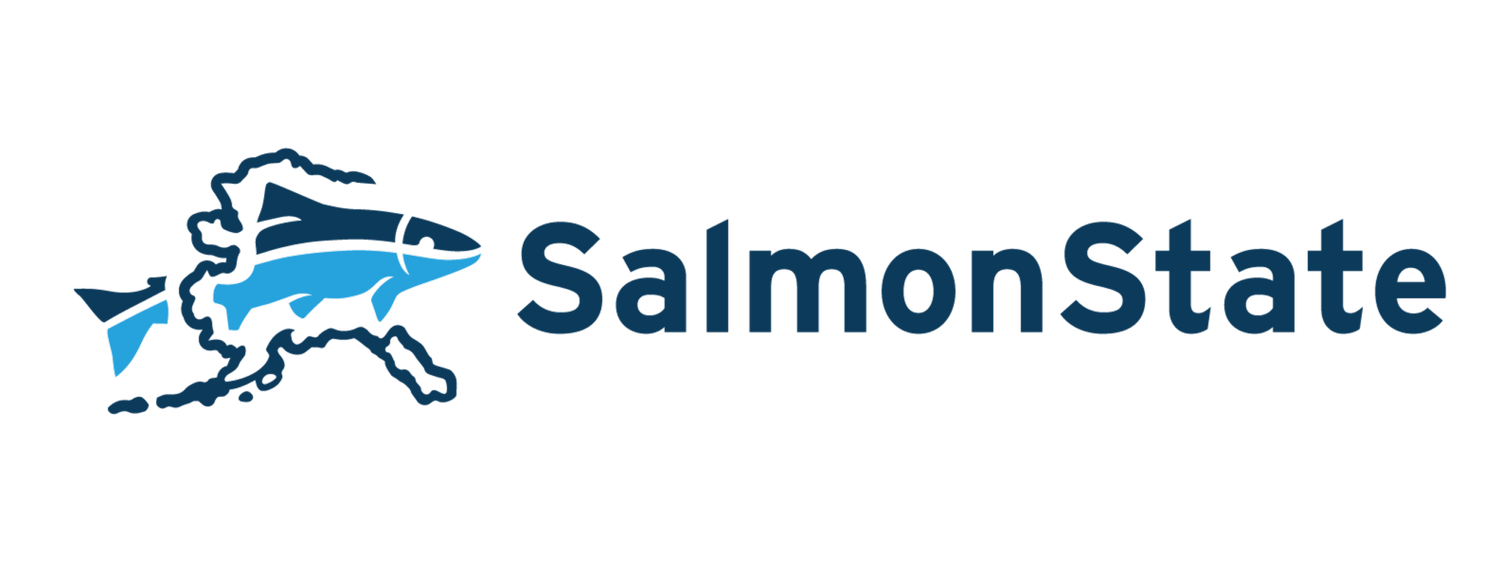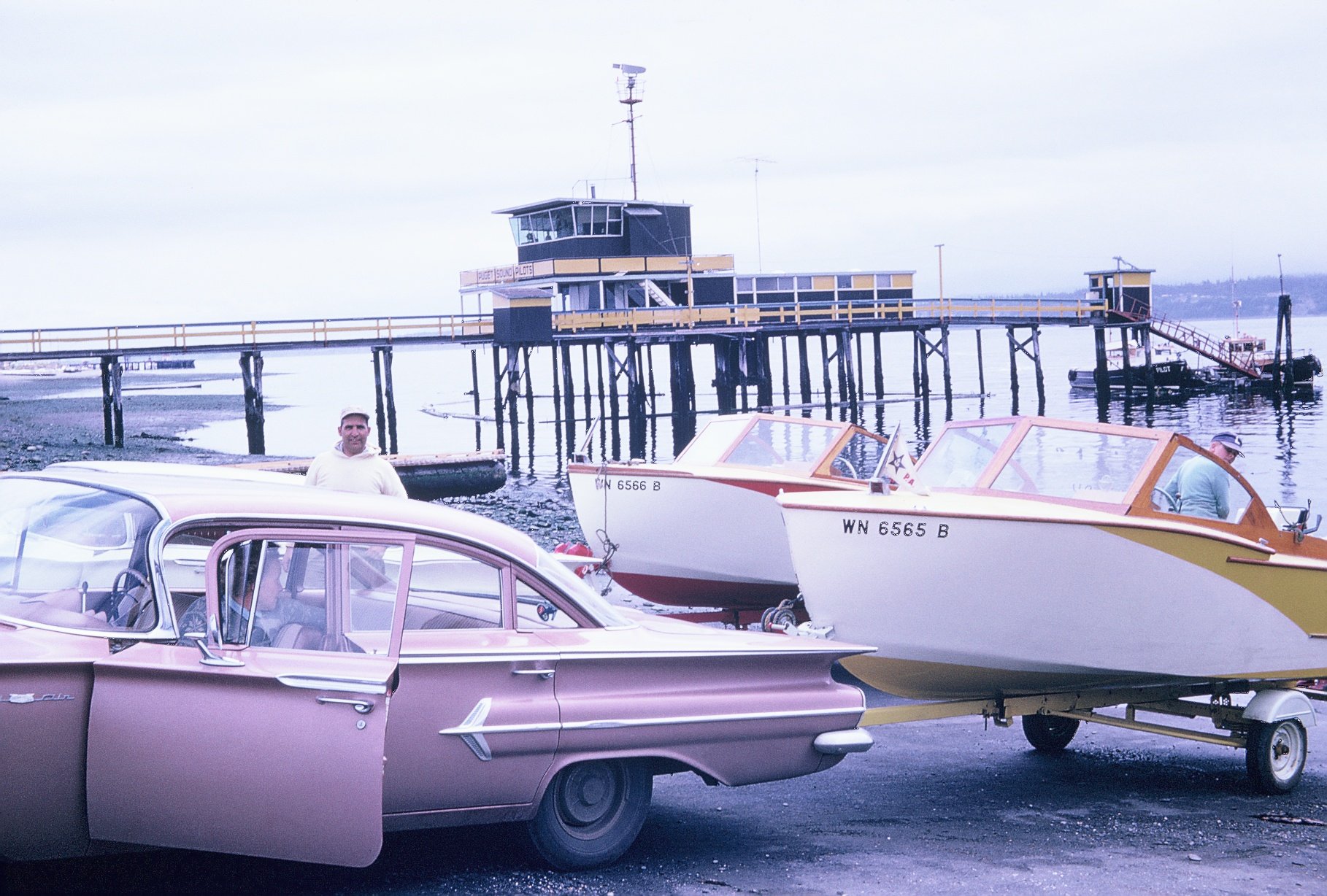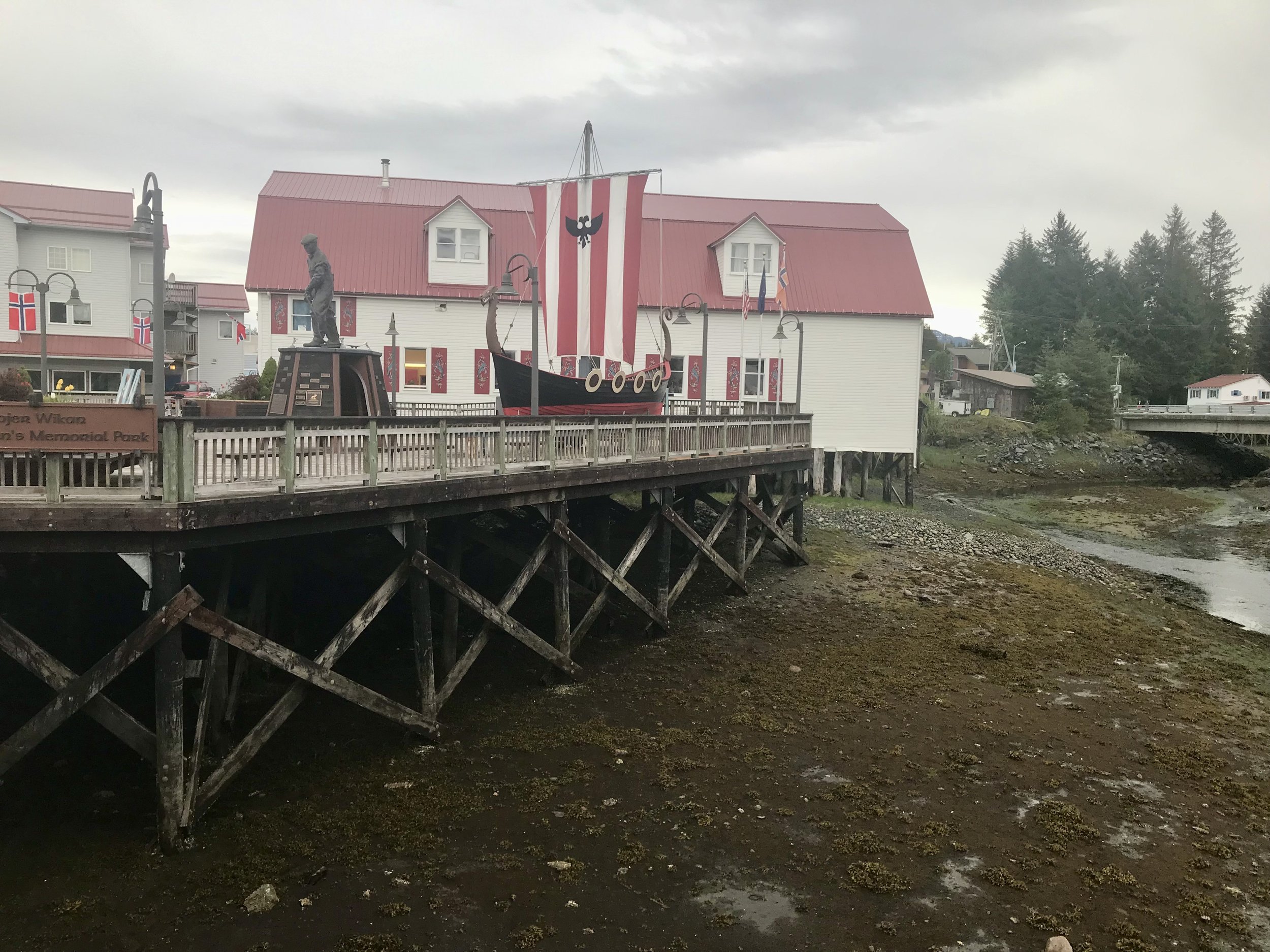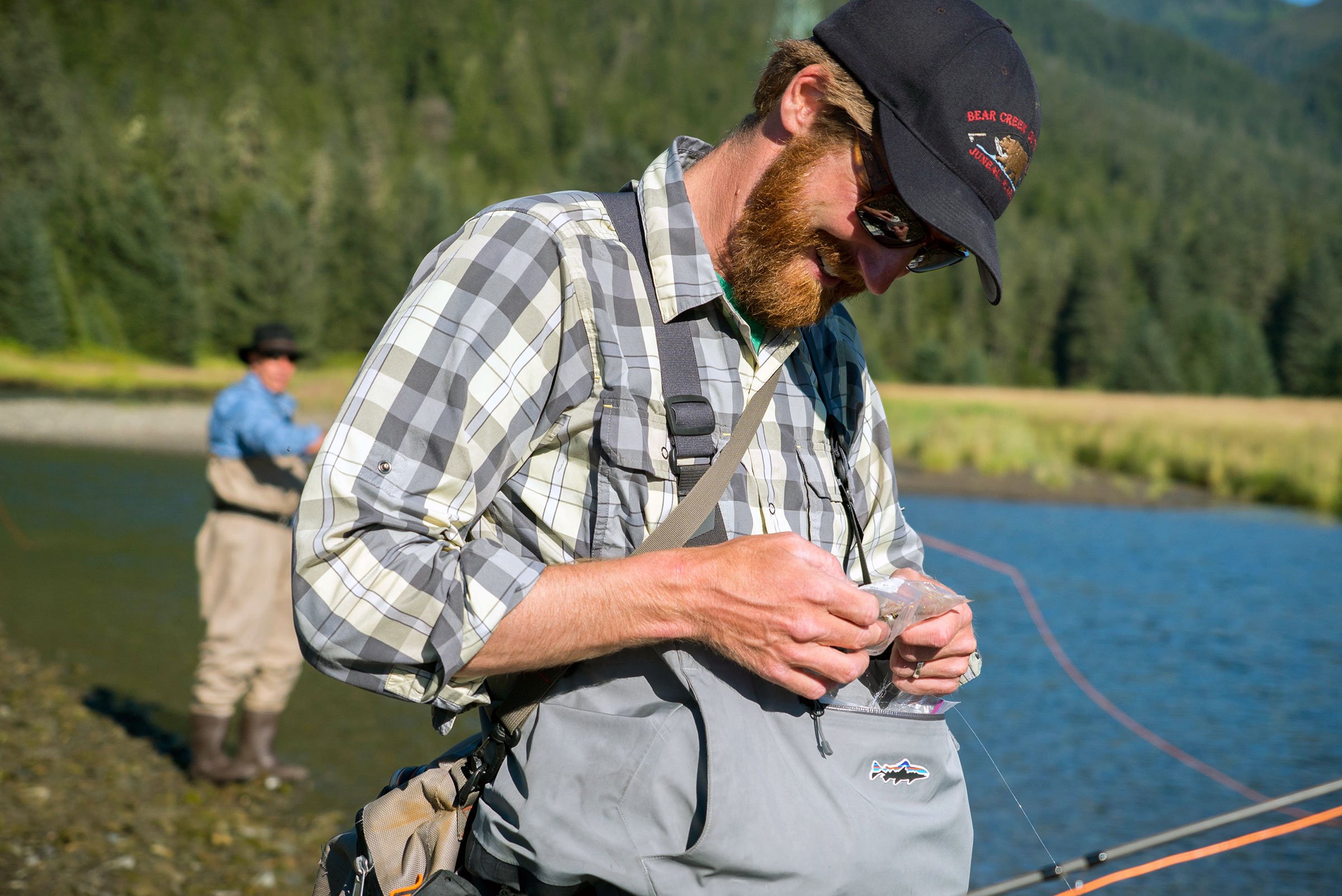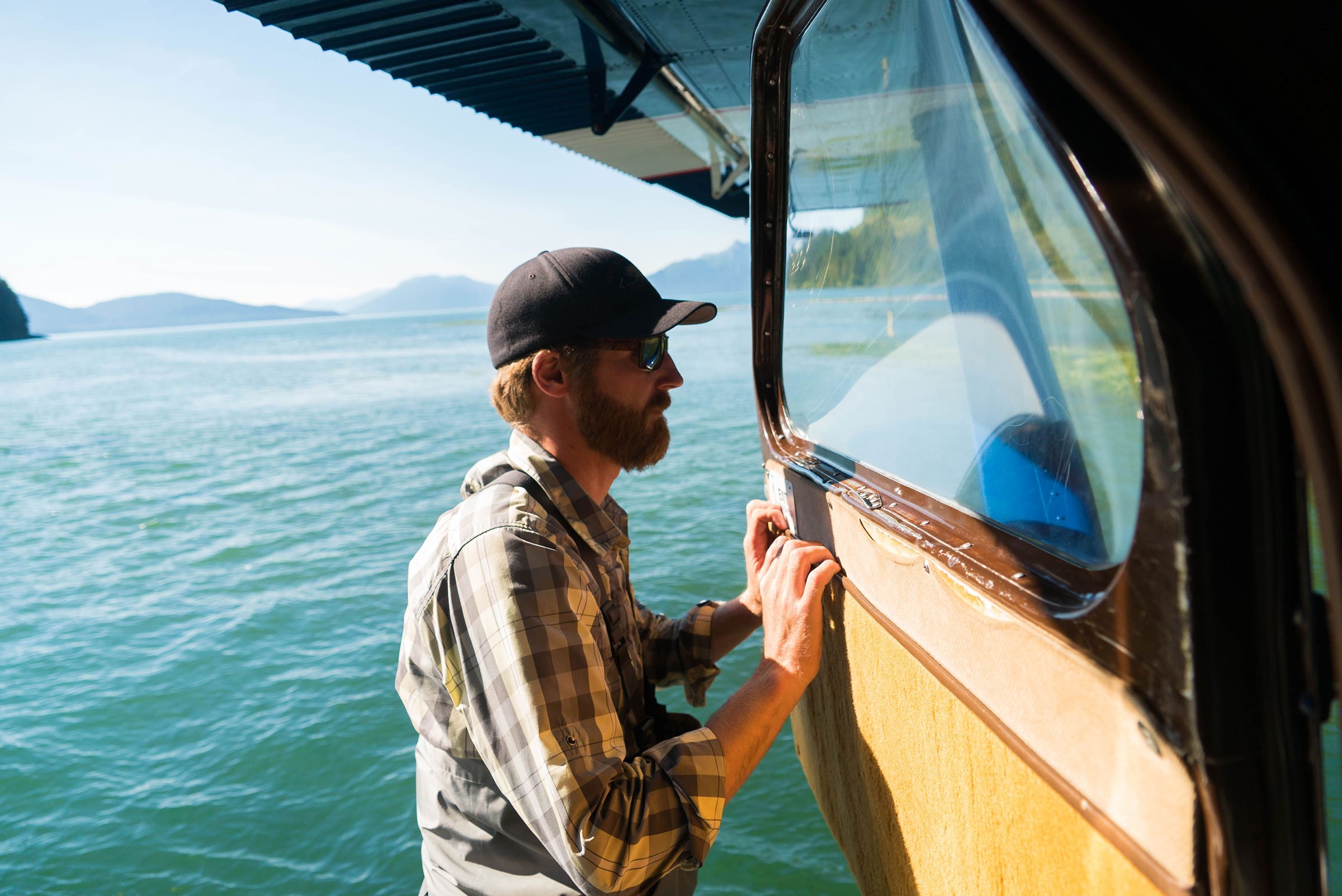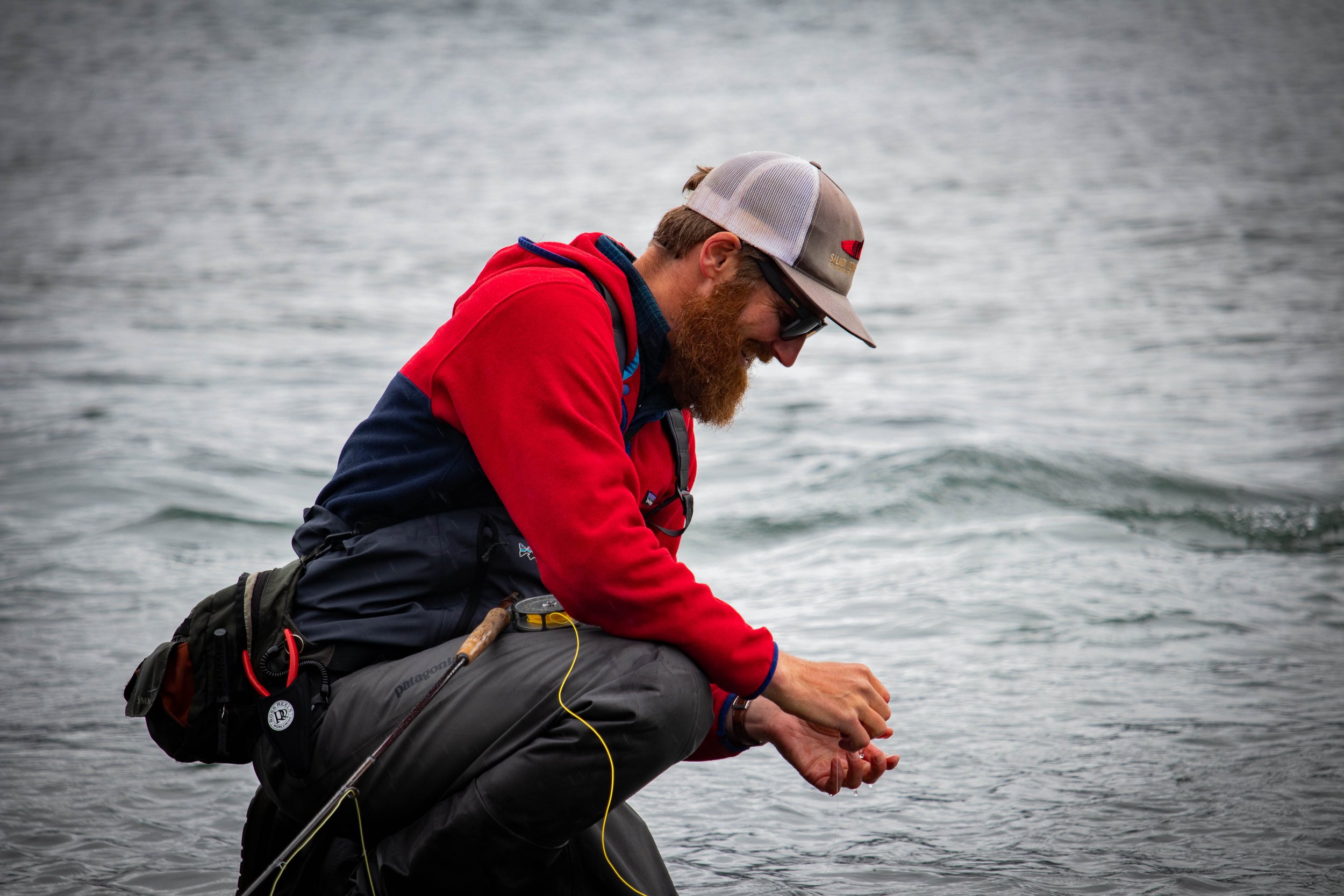Kevin Maier
“I grew up in Port Townsend, Washington. My parents weren’t fishermen, but my maternal grandparents were. They lived in Port Angeles, on the Olympic Peninsula about an hour away from where we grew up. Summers, my parents would take us to our grandparents’ house and drop us off for 10 days at a time.
My grandmother was retired from a career in the phone service. She loved to troll and sport fish more than anything. And so I spent a lot of my early years, from around age six to about 10 or 11, on the back of a little tiny fiberglass boat trolling with my grandmother, who was maybe five foot standing on her tippy toes. This tiny little Finnish woman who would laugh so hard that she would wet her pants. Just a hilarious, really jovial woman.
We weren't fishing downriggers at this time, just poles with banana weights. Nothing got her more excited than whenever the poles would start bouncing. That was what made her happy.”
—Kevin Maier, fly fisherman, guide, and Professor of English at the University of Alaska Southeast
Photo 4 by Lee House
“Partly as a function of declining runs in the Puget Sound, my grandparents lost the heart to go fish for salmon. So there was this long gap in my life where I didn't have anybody in my family that knew how to fish in rivers, or to do any other kind of fishing. It wasn't until college that I got back into fishing.
I'm a teacher now, and I know there are lots of different ways to learn. I learn by reading books. And I had a teacher in seventh grade, before Brad Pitt made the book famous, who assigned ‘A River Runs through It.’ I read this book, a beautiful book about family and fly fishing that many people know now. And someone came in and taught us to fly cast just for a day. And I think I maybe made five or six casts. But from that moment in seventh grade, I always kind of had it in the back of my mind.
I didn't have anybody that knew how to fly fish. So I checked out books from the library and I went to the hardware store and bought the cheapest fly rod I could, and really taught myself.
I spent the first year of my fly fishing career driving around all over western Washington, with really no idea what I was doing, looking for steelhead. I thought that if you grew up in western Washington, that was the fish you were supposed to pursue. If you know anything about winter steelheading, they call it the fish of 10,000 casts, right? But if you have no idea what you're doing, it’s the fish of 10,000 miles. Just driving around and walking around in these streams. It was a lot of learning by making mistakes.”
—Kevin Maier, fly fisherman, guide, and Professor of English at the University of Alaska Southeast
“I often tell people that moving or growing up in Port Townsend, in Washington, in the eighties, it was the era of the spotted owl.
There was a pulp mill in Port Townsend. There still is. And the town was pretty divided between those who worked in the pulp mill and the kind of groovier art and tourism economy.
The eighties spotted owl issue, especially in my town of Port Townsend, but also out on the Olympic Peninsula in Port Angeles, where there were families that were loggers, was really quite divisive, and I wasn't sure which side I fell on. I had friends whose families were making their income at the mill, friends whose parents were loggers. And friends like mine who were in education and in health care.
Growing up with that sort of divisiveness, but also being aware that the impact was real — they were pretty good on viewshed buffers at the time, but you could drive and see clearcuts pretty easily from my house. And I remember going to watersheds that mattered to me, especially when I was getting back into fishing and walking these streams — watersheds that were places where I did catch early steelhead were getting pretty actively logged and pretty fast.
Moving up the coast from Washington to here was an effort to chase the fish. I grew up in a culture that cared and knew about salmon, and it was part of our day to day life at a time when it was declining. Now, I think salmon in western Washington, tragically, is more of an icon. It's something you see thrown around at the Pike Place market. And it probably came from here. Whereas so many Alaskans, and so many people farther north, still have a real, lived relationship with fish.”
—Kevin Maier, fly fisherman, guide, and Professor of English at the University of Alaska Southeast
“I first came to Petersburg in the summer of 2001. I was housesitting a float house out the road. I had my bike. I'd ride into town. And I didn't know the first thing about fly fishing for salmon in saltwater. There weren't really freshwater options there. But an old timer at the bar told me a place I could go and cast flies for salmon. I rode my bike down this kind of sketchy dirt road, and there was just a wall of pink salmon. I'd seen runs like that in Washington hatchery chum and pinks. But I hadn't really seen wild pink salmon that way. It was one of those days where you couldn't make a cast without hooking a fish. It was just ridiculous. And I didn't really want to catch pink salmon. I wanted to catch the coho that were also there. But as I was down there, a pod of orcas came cruising by 30 feet from the beach. And I remember being a little bit afraid at first — not really knowing what to do with orcas — but just sitting there and watching this wall of pink salmon move up and down in this little inner tidal small creek, and the pod of orcas was working out front. It just felt like, ‘Oh, this place is alive.’
Now, when I go to Washington and other places, I try to imagine what they would be like with salmon like that.
And it’s tragic. You think, ‘Man, this is a river that meant a lot to me as a kid, and I spent a lot of time here, and I've never seen the abundance of wild fish like that.’ It just doesn't happen anymore.”
—Kevin Maier, fly fisherman, guide, and Professor of English at the University of Alaska Southeast
“I got here fresh out of a PhD program at Oregon, really committed to open discussions in the classroom. I was filling in for a colleague who taught in our Outdoor Studies program at the University of Alaska Southeast. The class had two overnight cabin trips built into it. I was supposed to take these students out to talk about their relationship to the natural world on these two cabin trips. And I thought, man, that's crazy. We're going to waste so much time. It meant canceling two weeks of class time. I thought that was nuts, but I had to do it. I was dreading it. I didn’t want to take those kids out there. I thought they wouldn’t care for it.
It was a big class, by university standards. Thirty people or so. The first night at the John Muir Cabin, everybody was really tired. We postholed through three feet of snow to get out to this cabin. And all of a sudden the three quiet girls in the class who never talked were leading discussion. There was just some magic that happened in outside environments.
And since that first semester now, 20 years ago, I pretty much take students outside in every class that I teach, even if it's just to walk down to Auke Bay and talk about fisheries management, or to look for herring in the harbor. I try to have overnight in pretty much all my upper division classes now.
And I think that finding ways to encourage people, even in a classroom setting, to go outside and have those connections to what's out there just amplifies whatever you're trying to do in the classroom anyway. And it’s something that I hope students take away from all those classes. It's easy to get outside and realize what we do have.”
—Kevin Maier, fly fisherman, guide, and Professor of English at the University of Alaska Southeast
Photos by Lee House
“I work at Bear Creek Outfitters. We typically take folks off the cruise ships fly fishing, and very often these people are from what I refer to as the Camo Belt. They’re from Oklahoma, from Ohio or Iowa. Places that are really far from coastal, temperate rainforest and really far from wild salmon. And they live in cities, and they're disconnected from the places where they actually live. And it's an opportunity to encourage people to think about the ways that all the things that they do are tied to the broader ecosystems that support all life. But you're reliant on getting tip money at the end of the day, and you're also trying to tell a story about this place that fits with their vision of what it is.
It's hard to cram into a 4, 6, or 8-hour tour. But there are a couple of things I always want to talk about — like that this is a place that is all salmon. Everything you're looking at here is marine-derived nutrient. And I also think, increasingly, it's important to talk about climate change.
We know from the data that only about 15% of Americans on any given week will have a conversation or even think about climate change. And we're not getting anywhere unless we actually have those conversations day in and day out. So having them on the land, in a place where they can see what connection and what abundance looks like, I think is poignant. And so I think that's the most important thing I do there. It's tricky because you're always trying to tell a story that is exciting to them.
So many of us who live here just take these places for granted. We just think that it's always going to be this way. And that’s not right.”
—Kevin Maier, fly fisherman, guide, and Professor of English at the University of Alaska Southeast
“I've always felt pretty strongly that when you live in a place, you should be engaged in the community. And that means volunteering on boards, and showing up at public hearings, and paying attention to the things that are going on in your backyard. And I've always just dragged my kids along. So they're used to going to rallies. They understand that they're going to hold the sign and people are going to take their picture and they're going to stand up and testify. Several years ago, there was a request to the City Assembly to sign on to a resolution about the transboundary mines. And I remember being in a packed city hall and bringing my boys down there. And I still have somewhere the piece of paper that Reed wrote his little testimony on, about wanting there to be king salmon for his kids. It was really special. He was maybe eight.
And my hope is that they carry those things forward. That they remain committed to community engagement in whatever form it takes.
My older boy, Reed, is 16 now. And he's out commercial fishing in Cordova. And, he was getting ready to go and he couldn't find his hat. He'd worn it commercial fishing last year. It needed to be sealed in a plastic bag and stored away somewhere because it smelled terrible. It's a green trucker hat that just says ‘We eat fish’ on it. And that was the hat that he wanted to wear commercial fishing. And my hope is that he understands what that means. It's not just a method to make a bunch of money in a short amount of time in the summer, but also a sustainable, future-looking career path.”
—Kevin Maier, fly fisherman, guide, and Professor of English at the University of Alaska Southeast
“I think in some ways the story of salmon decline in their historic range has been, as folks often say, a death by 1000 cuts. But some of those cuts are deeper and more damaging to the places that salmon need, especially on the habitat front. And I saw that with clearcut logging, especially on private land near my home in Washington when I was a kid.
And so I see the transboundary mines as both part of that long story of death by 1000 cuts– little spill here, a front loader there, a barge coming down the stream when it shouldn't be coming down the stream–but also a potential much, much deeper cut with catastrophic failure. And we know that earthen mine waste dams are prone to failure. That's going to happen. They're not going to last forever, despite what the permitting agencies might believe.
So I see the threats of these mines as both existential in a big way–catastrophic failure leads to pretty bad results for salmon– but also as part of that death by 1000 cuts. The slow picking away at all the things that salmon need.
And ultimately, I think the cool thing about salmon is they're fairly resilient creatures. They just need a few things. Cold, clear water that's connected. And if we can give them that, they're going to come back, and they're going to find ways to survive in a climate-changed and climate-weirded world.
That's the hopeful message. But it just requires a little bit of foresight.”
—Kevin Maier, fly fisherman, guide, and Professor of English at the University of Alaska Southeast
Photo 2 by Lee House
“I read yesterday that there's no state in the nation that has more freezers per capita than Alaska. And it's really true. I was like, oh, gosh, now that I think about it, I have four freezers. One for fish, one for deer. And part of the reason I'm here, and I'm raising a family here, is because the fish are here. And we still have a real lived relationship with salmon in a way that you just can't in Washington anymore. There, you get your five days to go out and troll for kings or your three days to only keep hatchery fish. We have wild salmon runs that are viable. And my kids can hop on their bikes and ride down here and catch wild salmon.
There aren’t many places in the world left like that.”
—Kevin Maier, fly fisherman, guide, and Professor of English at the University of Alaska Southeast
“People in Juneau, people in Southeast Alaska are really thankful for the support we've got from our congressional delegation and ongoing monitoring efforts. And there's been some great baseline science.
But even though we've been following and commenting on these issues for 10, in some cases, almost 20 years, we don't feel like we necessarily have a seat at the table or that people are listening to us. And before any more development happens in B.C., we need to have an opportunity to sit down with all the impacted groups, communities, Tribal entities, commercial fishermen, sport fishermen — all need to get together and weigh the costs and benefits of these things.
And I don't feel like that's happening right now. We have mining companies who are focused on the bottom line and that's it. Not thinking about what life is going to be like here in 50 years, 100 years. Seven generations. That's not in their best interest. But it's not in the interest of their shareholders and it's certainly not in the interests of our community to allow them to keep operating in this fashion.
Senator Murkowski recently elevated our concerns directly to President Joe Biden, and we're grateful. Now we need President Biden to do what the senator and so many Southeast Alaskans and Tribes have asked — and work to establish binding, international, locally and Indigenous-led protections for our wild salmon rivers.”
—Kevin Maier, fly fisherman, guide, and Professor of English at the University of Alaska Southeast
